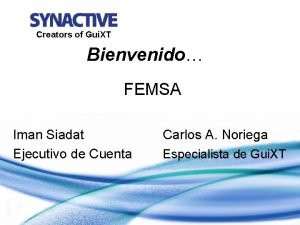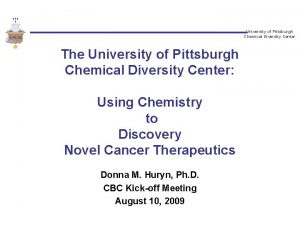In vitro intestinal toxicity of copper nanoparticles in

- Slides: 1

In vitro intestinal toxicity of copper nanoparticles in rat and human cell models M. F. Hughes 1 T. E. Henson 2, J. Navratilova 3, K. D. Bradham 4, K. R. Rogers 4 US EPA, ORD, 1 NHEERL and 4 NERL, RTP, NC; 2 SSC, RTP, NC; 3 NRC, RTP, NC Abstract Human oral exposure to copper oxide nanoparticles (NPs) may occur following ingestion, hand-to-mouth activity, or mucociliary transport following inhalation. This study assessed the cytotoxicity of Cu. O and Cu 2 O-polyvinylpyrrolidone (PVP) coated NPs and Cu 2+ ions in rat (IEC-6) and human intestinal cells, two- and three -dimensional models, respectively. The effect of pre-treatment of Cu. O NPs with simulated gastrointestinal (GI) fluids on IEC-6 cell cytotoxicity was also investigated. Both dose- and time-dependent decreases in viability of rat and human cells with Cu. O and Cu 2 O-PVP NPs and Cu 2+ ions was observed. In the rat cells, Cu. O NPs had greater cytotoxicity. The rat cells were also more sensitive to Cu. O NPs than the human cells. Concentrations of H 2 O 2 and glutathione increased and decreased, respectively, in IEC-6 cells after a 4 -h exposure to Cu. O NPs, suggesting formation of reactive oxygen species (ROS). These ROS may have damaged the mitochondrial membrane of the IEC-6 cells causing a depolarization, as a dose-related loss of a fluorescent mitochondrial marker was observed following a 4 -h exposure to Cu. O NPs. Dissolution studies showed that Cu 2 O-PVP NPs formed soluble Cu whereas Cu. O NPs essentially remained intact. For GI fluid-treated Cu. O NPs, there was a slight increase in cytotoxicity at low doses relative to non-treated NPs. In summary, copper oxide NPs were cytotoxic to rat and human intestinal cells in a dose- and timedependent manner. The data suggests Cu. O NPs have inherent cytotoxicity, without dissolving and forming toxic Cu 2+ ions, whereas Cu 2 O-PVP NPs are toxic due to their dissolution to these ions. Introduction The manufacture and use of nanoparticles (NPs) is increasing throughout the world today. Nanoparticles have different properties than microsized particles because of a higher surface area and potentially higher reactivity. Metal oxide NPs, such as copper oxide (Cu. O), have a variety of applications. Examples for Cu. O NPs include the coloring of glass and ceramics, catalyst, chemical sensor, doping materials in semiconductors and antimicrobial agents. Release and exposure to Cu. O NPs may occur during their manufacture, use and disposal. Oral exposure to these NPs may occur following inhalation and mucociliary clearance from the lung or incidental oral ingestion. The gastrointestinal tract toxicity of copper oxide NPs is not well known. This study examined the cytotoxicity of Cu. O (oxidation state II) and dicopper oxide (Cu 2 O, oxidation state I) NPs in rat and human intestinal cells. Materials and Methods (cont. ) • • • A 3 D tissue model of the human intestine (Epi. Intestinal™) was from Mat. Tek Corp. (Ashland, MA). The tissue is cultured with an air-liquid interface in 6 -well plates with media below it. The model contains enterocytes and a number of intestinal cell types. It is a highly differentiated, polarized epithelium. After receiving the tissue, it was placed in an incubator (37 o. C, 5% CO 2, 95% RH) for 24 hr before NP exposure. Cupric (II) oxide (Cu. O) nanopowder (<50 nm particle size) was from Sigma-Aldrich (St. Louis, MO). Dicopper (I) oxide (Cu 2 O) NPs (48 nm) coated with polyvinyl pyrrolidone (PVP) were from nano. Composix (San Diego, CA). NPs were suspended (1 mg/ml) in cell culture media with 10% fetal bovine serum. NPs were dispersed with a probe sonicator (3 x 3 secs @ 4. 5 W). IEC-6 cells and Epi. Intestinal™ tissue were treated with NPs (0 to 100 µg/ml) or Cu. SO 4 and incubated for 4 or 24 hr at 37 o. C, 5% CO 2, 95% RH. The positive control (PC) was Triton-X 100 and negative control was media. At the end of the exposure period, several cytotoxicity measurements were conducted: cell viability (MTS – IEC-6 cells; MTT - Epi. Intestinal™); GSH and H 2 O 2; mitochondrial polarity. Dissolution of Cu. O and Cu 2 O NPs in media was assessed over 24 hr. At selected time points, aliquots of media were spun through a 3 k. Da filter, the filtrate digested in HNO 3, and then analyzed for Cu by ICP-OES. The effect of simulated gastric fluids on Cu. O NPs and potential alteration on chemical and physical properties was assessed. Cu. O NPs (1 mg/ml) were incubated in water (p. H 2 - 6) with pepsin for 1 hr at 37 o. C and ultracentrifuged. The pellet was resuspended in water (p. H 7), incubated with pancreatin for 1 hr at 37 o. C and ultracentrifuged. The pellet was suspended in water (p. H 7), incubated with intestinal bile extract for 1 hr at 37 o. C and ultracentrifuged. Before each centrifugation step, an aliquot of the treated NPs was analyzed for hydrodynamic diameter and zeta potential in a Malvern Instruments zetasizer. After the last centrifugation step, the particles were suspended in media as described above, sonicated, diluted as described above and applied to IEC-6 cells for 4 or 24 hr and assessed for cytotoxicity using the MTS assay. Cytotoxicity of Cu 2 O NPs Cytotoxicity of Cu. SO 4 Rat IEC-6 cell viability was assessed following pretreatement of Cu. O NPs with simulated GI fluids. (Mean ± SD, N=11 -12. ****, p<0. 0001 compared to control. ) Results Cytotoxicity of Cu. O NPs Viability of rat IEC-6 cells and human Epi. Intestinal tissue after exposure to Cu. SO 4. (Mean ± SD, N = 4 -11; *, p<0. 05; **, p<0. 01; p< 0. 001; ****, p < 0. 0001. ) Dissolution of Cu. O and Cu 2 O NPs Materials and Methods Rat small intestine epithelial cells (IEC-6) from Advanced Tissue Culture Collection (Manassas, VA) were seeded at approximately 1 x 104 cells/well in a 96 -well microtiter plate and placed in an incubator (37 o. C, 5% CO 2, 95% relative humidity (RH)) for 24 hr before NP exposure. www. epa. gov/research Treatment Group 1, pepsin p. H 2; Group 2, pepsin p. H 3; Group 3, pepsin p. H 4; Group 4, pepsin p. H 5; Group 5, pepsin p. H 6; pancreatin and bile salts, p. H 7 for all groups Effect of Cu. O NPs on IEC-6 cellular GSH, H 2 O 2 and mitochondrial polarity To assess the cytotoxicity of Cu. O and Cu 2 O-PVP NPs in a rat 2 -dimensional and human 3 -dimensional model system of the small intestine. Note: The contents of this poster do not necessarily represent U. S. EPA policy. Effect of simulated GI fluids on the hydrodynamic diameter and zeta potential of Cu. O NPs Viability of rat IEC-6 cells and human Epi. Intestinal tissue was assessed after 24 hr exposure to Cu 2 O-PVP NPs. . (Mean ± SD, N = 3 -12. ****, p < 0. 0001 compared to control. ) Objective • Cytotoxicity of Cu. O NPs pre-treated with simulated GI fluids Viability of rat IEC-6 cells and human Epi. Intestinal tissue after exposure to Cu. O NPs. (Mean ± SD, N = 4 -11; **, p < 0. 01; ***, p < 0. 001; ****, p < 0. 0001 compared to control. The dissolution of the NPs in culture media was assessed over 24 hr. At selected time points, aliquots of media were spun through a 3 k. Da filter, the filtrate digested in HNO 3, and then analyzed for Cu by ICPOES. N=2 for each time point. Innovative Research for a Sustainable Future Detection of GSH and H 2 O 2 and mitochondrial polarity in IEC-6 cells after a 4 -hr exposure to Cu. O NPs Mean ± SD, N= 9 -12. **, S. D. from control, p < 0. 01; ****, S. D. from control, p < 0. 0001. FCCP and rotenone are positive controls for mitochondrial polarity measurement. Summary • Cu. O NPs (ox. state II) are cytotoxic to rat IEC-6 cells and human Epi. Intestinal. TM tissue in a timeand dose-dependent manner. The rat cells, a 2 -dimensional model, appear to be more sensitive to the Cu. O NPs than the human 3 -dimensional tissue model of the small intestine. The latter tissue may have biological properties limiting uptake of the Cu. O NPs and/or toxicity. • Cu 2 O NPs (ox. state I) appear to be less cytotoxic to rat IEC-6 cells than Cu. O NPs (II) after a 24 hr exposure. • Cu. O NPs are more cytotoxic to rat IEC-6 cells than Cu. SO 4 after a 4 and 24 hr exposure. This suggests that there are inherent properties in the Cu. O NPs that render them cytotoxic in contrast to ionized copper. • Cu 2 O NPs ionize to Cu ions more readily than Cu. O NPs. As Cu 2 O NPs are less cytotoxic than Cu. O NPs, it appears the latter particles may have inherent cytotoxic properties. • Simulated GI fluids had a modest increase in cytotoxicity of Cu. O NPs in rat IEC-6 cells • Cu. O NPs elicit oxidative stress and mitochondrial depolarization in rat IEC-6 cells.

